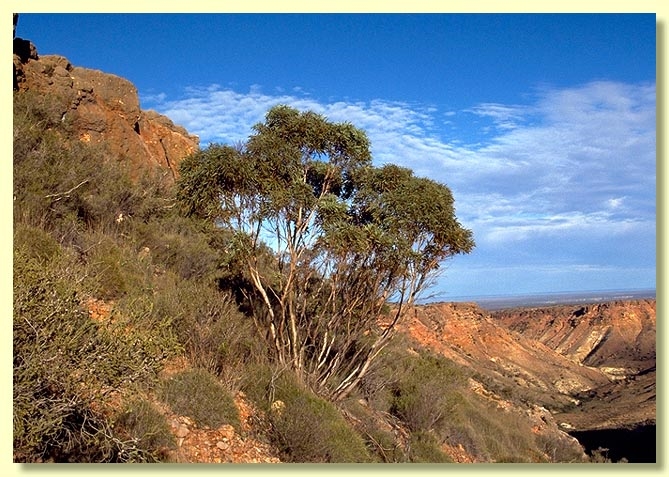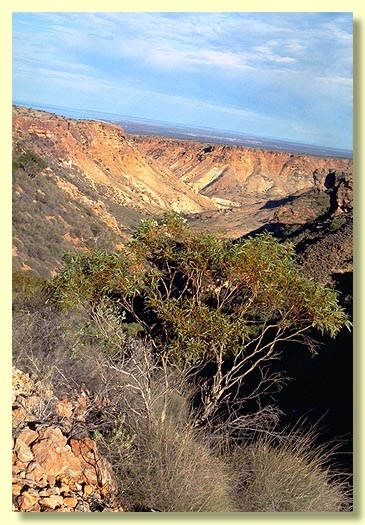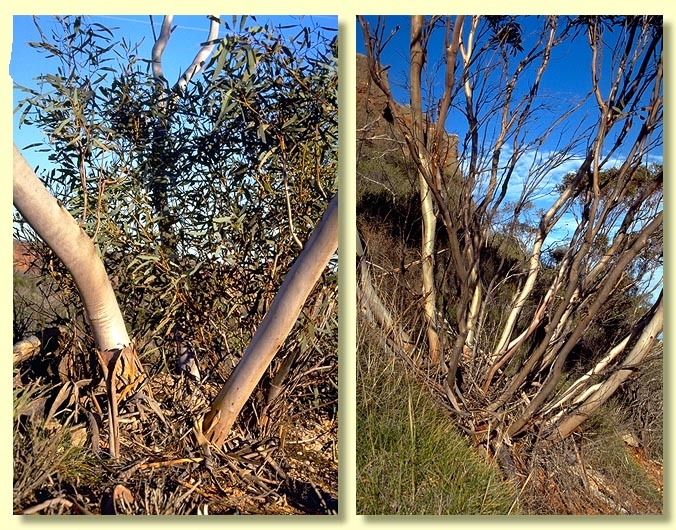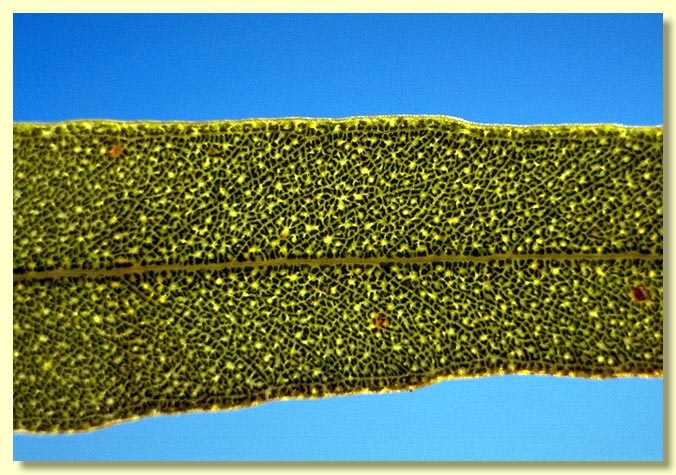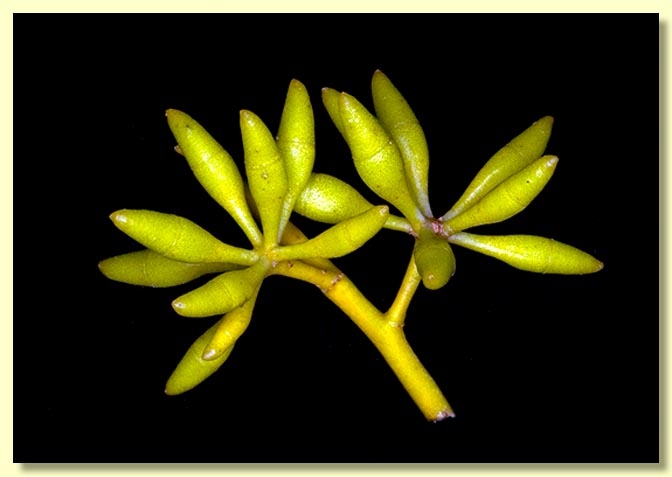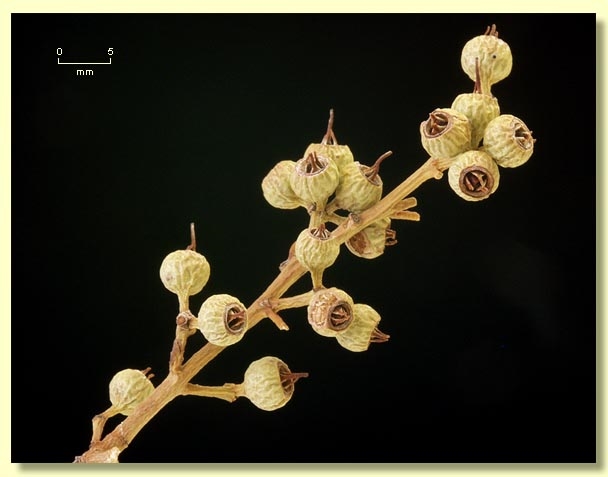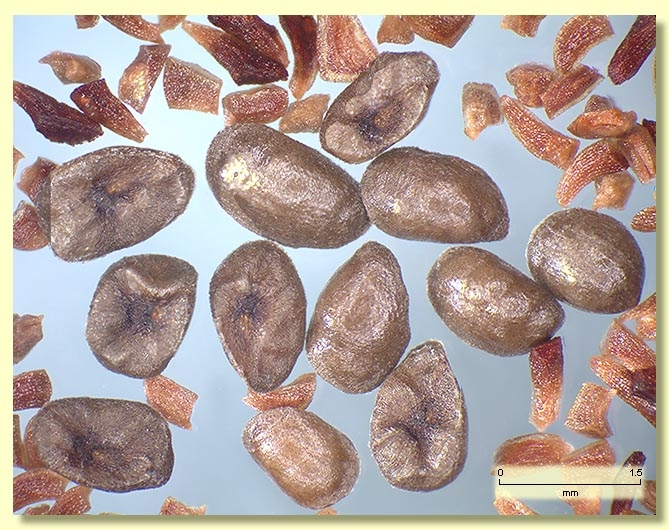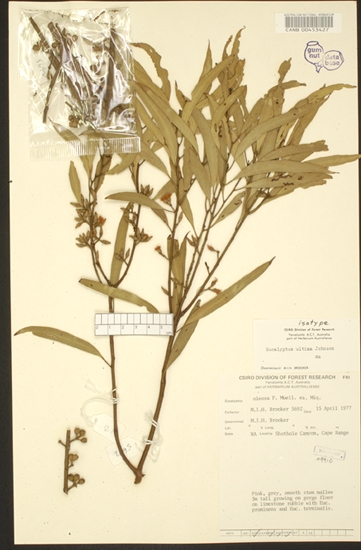Eucalyptus | Symphyomyrtus | Bisectae | Destitutae | Subulatae | Oleaginae
Euclid - Online edition
Eucalyptus ultima
Mallee to 4 m tall. Forming a lignotuber.
Bark smooth over most of the stems or occasionally some stems with fibrous rough bark for basal part to 0.5 m. Smooth bark grey to pink-grey to white over cream to coppery.
Juvenile growth (coppice or field seedlings to 50 cm): not seen.
Adult leaves alternate, petiole 0.3–1 cm long, linear to narrowly lanceolate, 5.5–10.5 cm long; blade 0.5–1.2 cm wide, base tapering to petiole, concolorous, dull blue-green at first, maturing to slightly glossy, green, side-veins acute or at an angle greater than 45° to the midrib, densely reticulate, intramarginal vein parallel to and just within margin, oil glands numerous and mostly intersectional.
Inflorescence axillary unbranched, peduncles 0.4–1 cm long, buds 9 to ?15, pedicellate, pedicels 0.2–0.4 cm long. Mature buds ovoid (0.5–1 cm long, 0.25–0.3 cm wide), scar present, operculum conical to horn-shaped (0.35–0.5 cm long), stamens irregularly flexed, anthers adnate to weakly versatile, basifixed, globoid, dehiscing by lateral pores, style long, stigma tapered, locules 3 or 4, the placentae each with 4 vertical ovule rows. Flowers white.
Fruit pedicellate, pedicels 0.2–0.3 cm long, truncate-globose to cup-shaped, sometimes slightly urceolate, 0.5–0.6 cm long, 0.4–0.5 cm wide, disc descending, valves 3 or 4, valve tips strongly exserted due to fragile style remnants.
Seeds light brown to grey, 1–2 mm long, ovoid or flattened-ovoid, occasionally with shallow longitudinal furrows on otherwise smooth dorsal surface, hilum ventral.
Cultivated seedlings (measured at node 10): cotyledons Y-shaped (bisected); stems ± round or 5 or more sided in cross-section; smooth, leaves opposite, sessile to very shortly petiolate and linear for the first 2 to 7 nodes then becoming alternate or, in some seedlings becoming spirally arranged, sessile to very shortly petiolate, linear, 4–8.5 cm long, 0.3–0.8 cm wide, dull green.
Flowering has been recorded in April and May.
A mallee restricted to the Cape Range area of the Northwest Cape on the mid-coast of Western Australia. Characterised by its smooth bark, the narrow semi-glossy adult leaves and the small truncate globose fruit.
Eucalyptus ultima belongs in Eucalyptus subgenus Symphyomyrtus section Bisectae subsection Destitutae because buds have two opercula initially, cotyledons are Y-shaped and branchlets lack oil glands in the pith. Within this subsection E. ultima is part of the large taxonomic series Subulatae further characterised by globoid basifixed anthers, grey smooth seeds with shallow longitudinal furrows, and fruit with persistent exserted style remnants. Series Subulatae is divided principally into four subseries based on the juvenile leaves, one with spiral, crowded seedling phyllotaxis (subseries Spirales), another with decussate and decurrent seedling leaves (subseries Decurrentes), another with decussate non-decurrent seedling leaves(subseries Decussatae), and a fourth, to which E. ultima belongs, with disjunct, petiolate seedling leaves (subseries Oleaginae).
The other members of the subseries Oleaginae are E. eremicola, E. kochii and E. longissima. E. ultima is distinguished by its mallee habit, smooth bark, narrow semi-glossy adult leaves and its very narrow linear seedling leaves. E. kochii and E. longissima differ by having rough bark over most of the stem. E. longissima differs further by normally being a much larger plant. E. eremicola subsp. eremicola differs only slightly by consistently having basal rough bark and by having slightly wider seedling leaves (E. ultima mostly smooth-barked, sometimes with rough bark for c. 0.5 m and with very narrow linear seedling leaves). E. eremicola subsp. peeneri has dull blue-grey to blue-green adult leaves.
Eucalyptus ultima is somewhat isolated geographically from other species of the series Subulatae, and with its small more or less truncate-globose fruit only 0.4-0.5 cm wide, conical to horn-shaped operculum, linear juvenile leaves and elevated habitat should not be confused with other species in the Cape Range area.
Eucalyptus ultima: Latin ultimus, farthest, most distant, referring its occurrence in the farthest of the range for the subseries Oleaginae.


